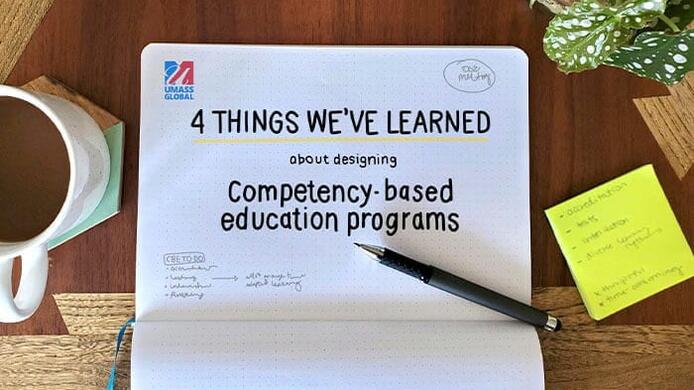UMass Global offers a wide variety of degree programs for adult learners. Explore your learning options and find a degree that fits you.

What is the future of the virtual education environment and is the model effective? We sought out the insights of the top leaders in the tech-ed landscape and compiled the most relevant resources for our own expert interview about online learning. Get inspired as they break down the facts about the innovations that are changing the world and for the better.
Top Questions Skeptics Ask About Online Learning
1. Is Online Education Trusted?
Online education was once both a revolutionary and scary thought, but today it is a strong and trusted source for quality training and learning. According to a recent Gallup poll featured by U.S. News and World Report, 37% of Americans said they agree or strongly agree that online colleges and universities offer high-quality education. In addition, one of our favorite stats compiled from the study is that nearly half of American business leaders say they would hire someone with an online degree to work at their company.
Brandon Busteed, executive director of Gallup Education, talks about the potential tipping point for online programs in higher education. He explains, "To see the increasing percentage of those who view that as a quality degree, you’re coming into territory where there could easily be a tipping point where people just start to accept online degrees as quality degrees. And I think that’s going to grow enrollments dramatically."
Amy Golod from U.S. News expands on the outlook on the online learning landscape by saying, "As online options become more prevalent among universities, they are earning a reputation as an alternative, but not less prestigious, route."
She continues on, explaining, "In addition to establishing programs targeting adult populations, some higher education institutions rely on new technology to increase traditional undergraduate and graduate student course and degree enrollment. The trend has influenced educational startup companies to offer innovative learning platforms and professional development opportunities."
These facts certainly attest to the quality of teaching and learning in the virtual environment.
2. Are Courses Online Interactive and Engaging?
Those that are skeptical of online learning often argue that, in the virtual world, students are missing out on the valuable face-to-face interaction with peers and instructors. Experts argue, however, that technology has actually enhanced interaction and engagement with content by using adaptive learning methods and leveraging the power of data. Taking college classes online nowadays is very common and gives students the ability to further their education while living a busy life. Online degrees in criminal justice and business are just 2 examples of the programs that University of Massachusetts Global is offering.
Adaptive Learning
Consider the effects of adaptive learning. The technique is utilized by millions of students from kindergarten through college in both fully online and blended settings. Its primary feature is that it varies the presentation of content according to the user’s experience, which means that education is personalized. Andrew Smith Lewis, co-founder of Cerego, a company that develops this type of technology, describes his system as “flashcards on steroids.” Cerego made learning fun by introducing gamification into the learning process. "The mechanics of a successful game are designed to keep you in this band between boredom and frustration," says Cerego's Smith Lewis. "We see a nice uptick in engagement and completion."
In this previous article we highlighted visionaries Daphne Koller and Salman Khan and their thoughts on the education revolution, and today we revisit their TED Talks and examples of how to design effective and engaging online courses. Koller elaborates on how online courses are designed to adapt to the individual learning styles of students. She says, "The first component is that when you move away from the constraints of a physical classroom and design content explicitly for an online format, you can break away from, for example, the monolithic one-hour lecture. You can break up the material, for example, into these short, modular units of eight to 12 minutes, each of which represents a coherent concept." Students can traverse this material in different ways, depending on their background, their skills or their interests.
"So, for example, some students might benefit from a little bit of preparatory material that other students might already have. Other students might be interested in a particular enrichment topic that they want to pursue individually. So, this format allows us to break away from the one-size-fits-all model of education and allows students to follow a much more personalized curriculum."
Data-Driven Decisions
The leadership duo points out how data can impact the effectiveness of both teaching and learning. Kahn states, “So our paradigm is to really arm the teachers with as much data as possible - really data that, in almost any other field, is expected, if you're in finance or marketing or manufacturing - and so the teachers can actually diagnose what's wrong with the students, so they can make their interaction as productive as possible.
The technology helps promote inquiry in a number of ways. Koller provides the following examples: “You can collect every click, every homework submission, every forum post from tens of thousands of students. So, you can turn the study of human learning from the hypothesis-driven mode to the data-driven mode, a transformation that, for example, has revolutionized biology. You can use this data to understand fundamental questions like, what are good learning strategies that are effective versus ones that are not? And in the context of particular courses, you can ask questions like, what are some of the misconceptions that are more common and how do we help students fix them?”
Kahn goes on to explain that in a traditional model of learning, most of the teacher’s time is spent on standard activities, lectures, and grading, estimating that about 5% of their time is actually sitting next to students and working directly with them. But online learning technologies have changed all that for the better by humanizing the classroom by a factor of five or ten. That truly is an incredible concept.
3. How Does Online Education Break Barriers?
It doesn’t just break barriers, it annihilates them. Education in the virtual world allows students to access information from anywhere in the world, which is a huge advantage when integrating different perspectives into courses. It has the power to create organic connections and communities throughout the world, uniting millions of people while advancing their societal contributions with new skills and knowledge.
Sebastian Thurn, the CEO of Udacity, spoke of the success of his organization’s platform at the World Affairs Council this week by saying, "Education is the thing that empowers people."
"Today you can find 12-year-old kids in Pakistan taking courses on Udacity. There’s a training center in Ghana that runs these classes. It’s stunning to me how much progress we’ve made in just two years.” This international reach proves the power of online schooling and its ability to connect lifelong learners who would have never had the chance to do so before.
Alternatively, in Koller’s classes, she found that because of the large online community, students interacted with each other in ways that were often deeper than they had experienced in the context of the physical classroom. For example, she shares that, “students also self-assembled, without any kind of intervention from us, into small study groups. Some of these were physical study groups along geographical constraints and met on a weekly basis to work through problem sets. This is the San Francisco study group, but there were ones all over the world. Others were virtual study groups, sometimes along language lines or along cultural lines, and on the bottom left there, you see our multicultural universal study group where people explicitly wanted to connect with people from other cultures.”
The catch 22 with integrating cultures can be the language and cultural barriers and teachers must learn to navigate through it. University of Massachusetts Global’s own professor, Dr. Sheila Lakshmi Steinberg, is an expert in creating community in an online environment, and recommends that teachers utilize a “Place-Based Approach.” Her model has six steps, including recognizing the physical factors of students' contexts, socio-economic factors, establishing varied types of interactions on an ongoing basis and documenting success.
4. What Does the Future Hold?
With all the innovation that has unfolded in recent years, what is around the corner for higher education? Here are just a few of the goals that some of the top movers-and-shakers have to help spread the spirit of lifelong learning.
Mobile-Friendly Content
There is no denying we live in a digital age that is powered by new, powerful mobile devices. Online learning must also advance along with technology. Modern students rely on their smartphones, tablets and laptops to accomplish projects and tasks on-the-go. In fact, according to Learning House's annual report with Aslanian Market Research (AMR):
87 percent of prospective online students use their mobile phones to search for potential programs online and 67 percent of have even completed online coursework through their smart phones since being enrolled.
This means if colleges and universities want to keep up with consumer behavior it will be crucial they adapt their websites and course content to effectively function on a mobile platform. Learning management systems (LMS) like Blackboard Inc.
Self-Paced Learning Models
Competency-based education (CBE) is the latest evolution in online learning. It was created to help free busy students from the restrictions common among time-based systems that award credits based on a set number of hours traditionally spent in a physical classroom environment. CBE programs however take into account the fact that many teachers and professors experience every day, which is that students learn at different paces, some master concepts faster than others and some concepts may take longer to grasp. By letting the students set their own “pace of learning” rather than following a structured semester format, it prevents learners from getting overwhelmed and allows those with existing skills to prove what they know and move on. As University of Massachusetts Global's chancellor, Gary Brahm points out in his interview with Chief Learning Officer: "It gives them a sense of confidence, and it makes every credit count."
Some schools like University of Massachusetts Global have already implemented these types of programs and they are gaining traction throughout the higher education landscape. The benefits of this model include flexibility, custom learning experiences, subscription-based tuition and the fact that previous knowledge gained through education or working experiences can help propel students through the program in potentially less time than a traditional learning model.
Are You Ready for Online Learning?
At University of Massachusetts Global, we thank all the thought leaders that have contributed to the innovations in the field of education, and continue to commit to paving the way for more to come. If you're wondering if online courses are right for you, consider checking out our article, "6 Signs You're Ready to Conquer the Online Classroom."





